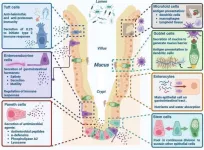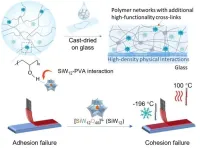(Press-News.org)
Introduction
Oxidative stress, caused by an imbalance between reactive oxygen species (ROS) and antioxidant defenses, plays a central role in the development of non-communicable diseases (NCDs). These diseases, including cardiovascular disorders, diabetes, neurodegenerative conditions, cancer, and liver and kidney diseases, are among the leading causes of morbidity and mortality worldwide. Enzymatic and non-enzymatic antioxidants serve as the body’s primary defense against ROS, maintaining redox homeostasis and preventing cellular damage. However, when ROS levels exceed the capacity of antioxidant defenses, oxidative stress ensues, contributing to disease pathogenesis. This review explores the mechanisms by which antioxidant-enzyme interactions regulate oxidative stress and their implications for managing NCDs.
Mechanisms of Antioxidant-Enzyme Interaction
Antioxidants mitigate oxidative damage through enzymatic and non-enzymatic pathways. Non-enzymatic antioxidants such as vitamin C, vitamin E, carotenoids, flavonoids, and polyphenols directly scavenge ROS or regenerate oxidized enzymatic antioxidants. Enzymatic antioxidants—including superoxide dismutase (SOD), catalase (CAT), glutathione peroxidase (GPx), glutathione reductase (GRd), and thioredoxin reductase—play crucial roles in neutralizing ROS.
The interplay between antioxidants and enzymes enhances the efficacy of the antioxidant defense system. For example, vitamin C regenerates vitamin E, while melatonin upregulates GPx and SOD activity, reducing oxidative stress. Similarly, flavonoids and polyphenols modulate the expression of antioxidant enzymes, exerting anti-inflammatory and cytoprotective effects.
Antioxidant-Enzyme Interactions in Disease Pathogenesis
Oxidative stress contributes to various NCDs through mechanisms such as lipid peroxidation, protein oxidation, DNA damage, and inflammatory signaling. The review highlights key interactions in different diseases:
Cardiovascular Diseases (CVDs): Antioxidants such as flavonoids, vitamin C, and vitamin E enhance the activity of SOD, CAT, and GPx, reducing ROS-induced vascular damage. Polyphenols inhibit lipid peroxidation and inflammation, lowering the risk of atherosclerosis and hypertension.
Neurodegenerative Diseases (Alzheimer’s and Parkinson’s Disease): Antioxidants like resveratrol, Coenzyme Q10 (CoQ10), and carotenoids improve neuronal survival by enhancing antioxidant enzyme activity. SOD and GPx protect neurons from oxidative damage, while vitamin E reduces peroxyl radicals implicated in neurodegeneration.
Cancer: Tumor cells exploit antioxidant pathways to survive under oxidative stress. While antioxidants can protect normal cells from ROS-induced DNA damage, excessive antioxidant enzyme activity in tumors may promote survival and resistance to therapy. Targeting SOD and GPx in cancer cells could enhance chemotherapy sensitivity.
Diabetes: Oxidative stress impairs insulin signaling and contributes to complications such as diabetic neuropathy and nephropathy. Polyphenols and flavonoids enhance the activity of SOD and CAT, improving glucose metabolism and reducing oxidative damage.
Liver and Kidney Diseases: Hepatic and renal oxidative stress leads to inflammation and fibrosis. Antioxidant therapy, including vitamins C and E, flavonoids, and polyphenols, supports enzymatic antioxidant activity, mitigating disease progression.
Therapeutic Strategies Targeting Antioxidant-Enzyme Interactions
Emerging therapeutic strategies harness antioxidant-enzyme interactions to manage NCDs. Key approaches include:
Dietary Antioxidants: Consuming polyphenol-rich foods, flavonoids, and vitamins C and E enhances antioxidant enzyme function.
Pharmacological Agents: Drugs that activate Nrf2, a key regulator of antioxidant responses, show promise in reducing oxidative stress-related damage.
Gene Therapy: Modulating the expression of antioxidant enzymes could provide targeted interventions for diseases like cancer and neurodegeneration.
Future Perspectives and Conclusion
Understanding the intricate interactions between antioxidants and enzymes is essential for developing effective therapeutic strategies for NCDs. While dietary and pharmacological interventions offer potential benefits, further research is needed to optimize antioxidant therapy. Future studies should focus on elucidating the molecular mechanisms of antioxidant-enzyme regulation, identifying novel therapeutic targets, and developing precision medicine approaches tailored to individual oxidative stress profiles.
By advancing our knowledge of antioxidant-enzyme interactions, we can improve the prevention and treatment of NCDs, ultimately reducing their global burden.
Full text
https://www.xiahepublishing.com/2572-5505/JERP-2024-00020
The study was recently published in the Journal of Exploratory Research in Pharmacology.
Journal of Exploratory Research in Pharmacology (JERP) publishes original innovative exploratory research articles, state-of-the-art reviews, editorials, short communications that focus on novel findings and the most recent advances in basic and clinical pharmacology, covering topics from drug research, drug development, clinical trials and application.
Follow us on X: @xiahepublishing
Follow us on LinkedIn: Xia & He Publishing Inc.
END
New research shows that turtles are responding to climate change by nesting earlier.
Researchers monitoring nesting green and loggerhead turtles in Cyprus have discovered they are returning to their regular nesting spots earlier each year to compensate for rising temperatures.
In sea turtles, temperature determines the biological sex of offspring, with more females born when it is warmer, as well as fewer successful hatchings when it gets too hot.
Turtles also have “natal philopatry”, which means they return to nest in the area where they themselves hatched.
A research team from the University of Exeter and the Society for the Protection of ...
A new study from Western New England University (WNE) has revealed that long-term grape consumption significantly impacts muscle health, with notable benefits for both men and women. The research, published in the journal Foods, suggests that a diet including grapes can modify gene expression in muscle, potentially offering a new nutritional strategy for maintaining muscle mass and function.
Around 30 million tons of grapes are consumed every year, and their benefits extend beyond nutrition. Grapes have been shown to ...
INDIANAPOLIS – Chronic pain is complex and difficult to treat. Prescribing opioid pain medications has become controversial but may help some patients.
With the goal of informing clinician practice, a new study explores the harms and benefits of continuing and of discontinuing the long-term prescription of opioid medicines to adults with chronic pain. The authors analyzed the opinions of 28 experts on the harms versus benefits of maintaining, tapering or terminating opioid pain medication prescriptions ...
The National Academy of Inventors (NAI) has announced the 2025 class of Senior Members, comprised of 162 emerging inventors from NAI’s Member Institutions. This year’s class of NAI Senior Members is the largest to date and hails from 64 NAI Member Institutions across the nation. Collectively, they are named inventors on over 1200 U.S. patents.
“To see this program grow year over year is a testament to the dedication our Member Institutions have to fostering innovation on their campuses and supporting their inventive staff ...
Narcissists feel ostracized more frequently than their less self-absorbed peers, according to research published by the American Psychological Association. This may stem not only from being shunned due to their personalities but from a tendency to misinterpret ambiguous social signals as exclusion.
“Feeling ostracized is a subjective experience based on the perception of social cues by the individual. Some may be intentionally ostracized, while others may merely believe they are being excluded when that’s not the case,” said lead author Christiane Büttner, PhD, of the University of Basel. “Our findings suggest that ...
The intestinal epithelium is a highly dynamic barrier that regulates digestion, absorption, immune responses, and communication between the gut microbiota and the nervous system. To maintain homeostasis, intestinal epithelial cells (IECs) must efficiently manage protein production and secretion, a process tightly controlled by the unfolded protein response (UPR).
New research published in eGastroenterology demonstrates that disruptions in the UPR contribute to inflammatory bowel diseases (IBD), colorectal cancer, and other gut-related disorders. This highlights potential therapeutic strategies to restore ...
A little movement could help prevent dementia, even for frail older adults, suggests a new study led by researchers at the Johns Hopkins Bloomberg School of Public Health.
The researchers found that engaging in as little as 35 minutes of moderate to vigorous physical activity per week, compared to zero minutes per week, was associated with a 41% lower risk of developing dementia over an average four-year follow-up period. Even for frail older adults—those at elevated risk of adverse health outcomes—greater activity was associated with lower dementia risks.
The ...
Water-based adhesives face several challenges despite their environmental benefits. One major issue is that achieving high adhesion strength on various substrates, especially in wet or humid conditions, is difficult due to the inherent properties of water-based systems. Additionally, the volatility of water also leads to issues like bubble formation and uneven drying, affecting the adhesive's performance and appearance. Moreover, formulating water-based adhesives with both high solids content and low viscosity is technically demanding, ...
Philadelphia, February 20, 2025 – Researchers from the Mitochondrial Medicine Program at Children’s Hospital of Philadelphia (CHOP) have better characterized a spectrum of what were classically considered discrete mitochondrial DNA deletion disease syndromes. The findings offer new insights into genetic causes, potential symptoms, and disease progression, and may inform future clinical trial development. The findings were published today in the journal Genetics in Medicine.
Mitochondrial disease refers to a group of disorders that affect the mitochondria, which are tiny compartments present in almost every cell of the body that ...
A longer paternity leave after the birth of a child can improve the co-parenting relationship between moms and dads in a key way, a new study finds.
Researchers found that mothers were less likely to discourage fathers’ involvement in parenting if the dads had taken more time off after their child was born.
“When fathers take longer leaves, mothers might take that as a sign that fathers are more interested in being an active parent and be less likely to try to prevent them from participating in child care,” said Reed Donithen, ...


